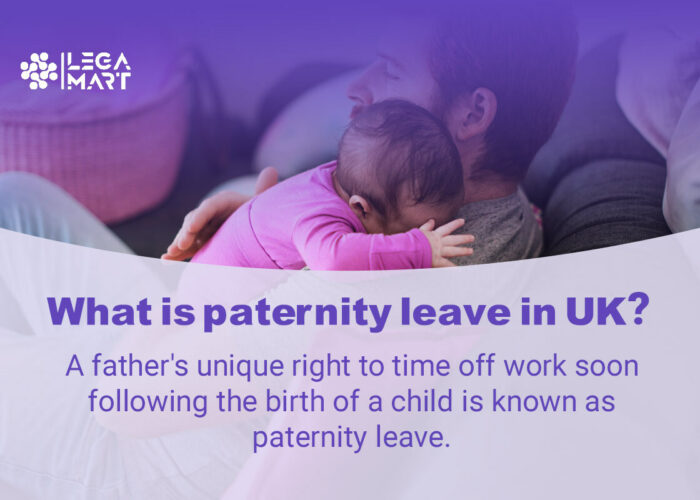- Introduction
- What is maternity leave?
- How long is maternity leave?
- Maternity rights
- What is paternity leave in UK?
- Statutory Paternity Leave in UK
- Paternity leave and pay
- Developments on extending paternity leave in UK by the Chartered Institute of Personnel and Development (CIPD)
- Shared parental leave
- Adoption leave and pay
- Eligibility in case of adoption
- How to claim paternity leave or pay?
- Frequently Asked Questions
- Conclusion
Introduction
According to HMRC data for the year ending March 31 2022, in contrast to the 636,000 mothers who took maternity leave, only 204,000 fathers availed paternity leave in 2021/22, amounting to one-third of the eligible fathers. Equally, an examination by the EMW law firm discovered that just a third, representing (32%) of eligible fathers, availed paternity leave in the previous year, resulting in an appeal for employers to improve this benefit. The investigation also revealed that the number of paternity leave claimants has remained comparatively consistent since 2012-13. The only change occurred during the pandemic, where the number reduced from 208,000 in 2019-20 to 161,000 in 2020-21.
Spending time with a baby can be one of the most significant moments in a man’s life. Therefore, it’s essential at this critical time to take a break from work. Paternity leave, though, is frequently misinterpreted. Is it on par with parental leave? How much vacation time do fathers get? Can it be pushed back? You’ll find some basic solutions below because we like to keep things straightforward.
What is maternity leave?
Maternity leave is a period that a woman takes off from work before and after giving birth to a child. Pregnancy, childbirth, and the immediate aftermath are all included under maternity leave. Its goal is to protect a woman’s and her child’s health during the perinatal period due to the unique psychological and physical demands of pregnancy and childbirth. It is a crucial component in defence of female workers during the perinatal period.
How long is maternity leave?
Statutory Maternity Leave: Employees who qualify may take up to 52 weeks of maternity leave. The term “Ordinary Maternity Leave” refers to the first 26 weeks, and “Additional Maternity Leave” refers to the latter 26 weeks. The earliest leave can be taken 11 weeks before the expected delivery week. After giving birth, employees are required to take at least 2 weeks off (or 4 weeks if they work in manufacturing). During maternity leave, an employee’s employment rights are safeguarded, including the rights to compensation, holidays, and work reinstatement. Even if you quit trading, you must still make SMP payments.
Statutory Maternity Pay (SMP): SMP for qualified workers may be paid for up to 39 weeks, typically in the following ways: the initial six weeks: The remaining 33 weeks: 90% of their average weekly earnings (AWE) before taxes. or 90% of their AWE, £156.66 (whichever is lower). It is necessary to subtract tax and national insurance. If your employer has a maternity programme, you can offer more than the minimum required by law. You must ensure that the staff is aware of and has access to your maternity leave and pay policy.
If the baby is born early/dies: If the baby is delivered early, leave begins the day following the birth. The worker is required to provide you with the child’s birth certificate or a letter from a physician or midwife attesting to the child’s true birthdate. The revised end date for their leave must be communicated in writing to them.
If your payroll software includes this option, you can use it to calculate SMP for very premature births where the infant is delivered 15 weeks or more before the due date. If not, you’ll need to figure it out manually. If a baby is stillborn or dies after birth after the start of the 24th week of pregnancy, the employee is still entitled to leave or compensation.
Maternity rights
You might be eligible for maternity leave and pay. While you are pregnant at work and on maternity leave, you also enjoy additional maternity rights.
- Maternity leave allows you to take up to a year off work while expecting a child.
- You should also confirm what maternity pay you are entitled to because not everyone who receives maternity leave also receives maternity pay.
- Your partner may also be entitled to compensation and vacation time.
- While on maternity leave, you can be eligible for maternity pay or the Maternity Allowance. Typically, this is less than your ordinary salary.
- You are entitled to whatever pay review you would typically receive.
What is paternity leave in UK?

A father’s unique right to time off work soon following the birth of a child is known as paternity leave. Other time off taken for kids are typically referred to as “parental leave.” Some dads choose to take annual leave in place of or in addition to paternity or parental leave, especially when those options are limited or poorly compensated. In this research summary, we refer to any leave fathers take in the months leading up to and during their child’s first year of life.
Statutory Paternity Leave in UK
Statutory Paternity Leave in UK allows employees to take one or two consecutive weeks’ leave, which remains the same even if they have multiple children, such as twins, triplicates, or quadruplicates.
The paternity leave cannot begin before the birth of the child, and the start date must either be: the actual date of birth, an agreed number of days after the birth, or an arranged number of days after the expected week of childbirth. Additionally, the leave must conclude within 56 days of the birth or the due date if the baby is born early.
Paternity leave and pay
- Depending on how long they’ve been employed, new fathers in the UK are entitled to up to two weeks of continuous paternity leave.
- By the end of the 15th week before the week your baby is due, you must have worked for the same employer for 26 weeks to be eligible for the entire benefit. A “week” is equivalent to a typical workweek. Therefore, working Monday through Friday is five days, whereas Monday through Wednesday is only three. In such a situation, two “weeks” would equal six days.
- The allowance does not change based on how many children you have. So, you wouldn’t get 16 weeks for octuplets.
- Additionally, you are entitled to time off to attend two antenatal checkups with your spouse (up to 6.5 hours each).
- While on paternity leave, fathers’ work rights are safeguarded. This covers your entitlement to wage increases, the building up of holiday pay, and going back to work.
- Additionally, you may be eligible for shared parental leave and the ability to split your partner’s income. Additionally, you can divide it up by taking intervals of time off between work periods. Paternity leave in UK is compensated in some circumstances.
- Typically, you must have worked for your employer for at least 26 weeks and provide them with ample notice before taking a leave of absence (at least 15 weeks). The government pays statutory paternity pay.
Paternity leave in UK for the self-employed
Statutory paternity pay and the associated leave are only available to those with work contracts. There isn’t currently a comparable system in place for independent contractors. In light of this, expectant fathers who are self-employed should plan how much time off they can take after the birth of their child and how this would influence their income. To determine if you qualify for assistance, you should also research the UK’s family and child benefits.
Extension of Paternity Leave in UK

It can be extended, yes. There aren’t any official guidelines for extending it, but there may be justification in some situations. Managers may make allowances and give some paid or unpaid time off if postpartum problems need to be addressed. As the child becomes older, you do have the rights to parental leave. If you’ve worked for your company for at least a year, you’re eligible for up to 18 weeks of unpaid leave per year. However, because this must be taken in blocks of a week, it is more appropriate for handling a pressing matter, such as a severe illness, than for last-minute childcare problems.
Developments on extending paternity leave in UK by the Chartered Institute of Personnel and Development (CIPD)

The UK government introduced additional paternity leave in 2011, allowing fathers to take up to 26 weeks of leave in addition to the 2 weeks of statutory paternity leave. However, this was replaced by Shared Parental Leave in 2015, which allows eligible parents to share up to 50 weeks of leave and up to 37 weeks of pay.
On the other hand, the CIPD has strongly advocated for extending paternity leave in UK, arguing that it can have positive benefits for both fathers and employers. The Chartered Institute of Personnel and Development (CIPD) is a professional association for human resource management professionals in the UK.
CIPD carried out a survey, which included 2,000 senior decision-makers in the UK, and almost half of the participants expressed their support for the extension of statutory paternity leave.
According to the CIPD 2020 report, data collected by the CIPD suggests that SPL initiatives are not thriving, resulting in a demand for reform by many HR experts, including those at the CIPD. Therefore, the potential extension or replacement of paternity leave in UK may be contingent on the performance of shared parental leave (SPL).
If the uptake of SPL remains low, there may be a possibility of introducing an updated version of paternity leave. The Uptake of SPL is low for several factors. For example; – the complexity of SPL schemes often leads to a delay in its implementation by many businesses until an employee demands it as their legal entitlement, and companies that do provide SPL typically observe low uptake for the same reason being a lack of employee comprehension regarding its operation.
Shared parental leave
A great technique to guarantee that both parents have a close bond with their new kid and share parental responsibilities is through shared parental leave.
- You and your spouse may be qualified for both ShPP and SPL if you’re expecting a kid or adopting a child. SPL is a shared parental leave programme (Statutory Shared Parental Pay).
- Within a year of the birth, you can split up to 50 weeks of leave and up to 37 weeks of salary between you (or Adoption).
- Only when the child is born or adopted can either be done. And both parents can take leave at the same time, or take it in turns. How this is arranged is up to discussions with the employer.
Eligibility for shared parental leave
- Shared leave and pay may be available to working parents who split primary responsibility for child care.
- By 16 weeks prior to the due date, they both had to have maintained steady work for 26 weeks, earning a minimum of £120 a week.
- They must give at least 8 weeks’ notice and remain employed by their employers during their leave.
- To receive shared salary and leave, their jobs must be employment rather than simply labour. Gig workers and contractors are, therefore, ineligible.
If you require the full breakdown of eligibility, you may contact the expert attorneys listed at Lega Mart.
Adoption leave and pay

Eligibility in case of adoption
- By the “matching week,” you must have worked for your employer consistently for at least 26 weeks.
- If you’re adopting a kid in the UK, this is either the end of the week you’re matched with the child, the child’s arrival date, or the date you want your payment to begin (overseas adoptions).
- The father, the husband or partner of the mother (or adopter), including same-sex partners, the child’s adopter, or the intended parent (if you’re having a baby through a surrogacy agreement) must be taking time off work to care for the child.
Start and end dates of the paternity leave: Your paternity leave can begin on the day of placement, a predetermined number of days later, the day the kid arrives in the UK or a predetermined number of days later (only for international adoptions), the day the child is born, or the day after if you have a job that day (surrogate parents). Leave must be taken within 56 days of the child’s arrival in the UK or the placement date (overseas adoptions). If you want to change your start date, you must provide your employer with 28 days’ notice.
How to claim paternity leave or pay?
- When requesting leave (within 7 days of your co-adopter or partner being matched with a child) or pay (within 28 days of when you want your pay to begin), you must use form SC4 (or your employer’s version).
- The form and notice time is different for adoptions taking place abroad. Form SC5 explains the procedure.
- To be eligible for leave and compensation, you must also fulfil additional requirements.
- If you used paid time off to travel to adoption appointments, you are not eligible for paternity pay or leave. If you take shared parental leave, you are not eligible for paternity leave.
Surrogacy arrangements
- If you utilise a surrogate to conceive a child, you must be married, share parental responsibility for the kid with your spouse, and have worked for your employer continuously for at least 26 weeks by the end of the “qualifying week” to be eligible for paternity pay and leave (the 15th week before the baby is due).
- Tell your employer when the baby is due and when you plan to start your leave at least 15 weeks before that date; they could ask for this information in writing.
- Your employer might need a formal declaration stating that you intend to file for a parental order within six months of the birth of the kid. You must sign this with a witness present.
Unpaid time off to look after your child
- Employees who qualify may take unpaid parental leave to attend to the well-being of their children, spend more time with them, consider new schools, transition their kids to other daycare centres, or spend more time with family, such as visiting grandparents.
- During parental leave, they are still entitled to their employment rights, including the right to pay, holidays, and return to work.
- Family leave is unpaid.
- Up until the age of 18, you are entitled to 18 weeks of leave for each biological child and adoptive child. 4 weeks for each child is the maximum amount of parental leave that each parent may take in a calendar year (unless the employer agrees otherwise).
- Unless your employer agrees, you must take parental leave as full weeks (1 week or 2 weeks) rather than individual days.
- You don’t have to take all the leave at once. A ‘week’ equals the length of time an employee normally works over 7 days.
Come to antenatal appointments with your partner
- You are entitled to paid time off from work during your pregnancy to attend any prenatal appointments that your doctor, nurse, or midwife prescribes.
- This could involve parenting, relaxation classes, or going to the doctor.
- If you are eligible for maternity leave, you have a right to this time off. It makes no difference how long you’ve been employed by your employer or how many hours you put in.
- If you’ve worked for the same employer for at least 12 weeks straight and you’re an agency worker, you can also take this time off.
- On a day that you have an appointment, you ought to receive your regular income.
- You cannot be required to work more hours by your employer to make up for your absence.
- Your spouse could also be able to take time off for 1 or 2 appointments.
Frequently Asked Questions
How long is paternity leave in UK?
Statutory paternity leave in UK is currently two weeks. Eligible employees can take the leave within 56 days of the birth or adoption of a child.
Who is eligible for paternity leave in UK?
To be eligible for paternity leave in UK, employees must have worked for their employer continuously for at least 26 weeks by the end of the 15th week before the expected due date or the date of the adoption placement.
How much is the pay for paternity leave in UK?
Statutory paternity pay in the UK is currently £151.97 per week or 90% of the employee’s average weekly earnings, whichever is lower.
Conclusion
Organisational culture, including the company’s commitment to caring values, level of “father friendliness,” and support for equal opportunities for women, as well as the fathers’ perceptions of support from top managers and work group norms that reward task performance over long hours at the office, all have a significant impact on how often employed men use parental leave.
The parental leave laws of a nation significantly impact the utilisation of leave by men. It’s noteworthy to notice that fathers frequently make assumptions rather than formal calculations when they claim they “cannot afford” to take a vacation. It has never been easy to evaluate the impact of public information campaigns on gender equality, including fathers’ uptake of leave.
To make sure that you are looking at the latest provisions and the most up-to-date information, particularly regarding amounts of time-off allowed and any payment that you might be entitled to, the best thing to do is to look at the Gov.UK website, which gives straightforward information which is always kept up-to-date.
Legamart offers the best solution for your issues regarding custody of the child. They have a network of excellent lawyers who can advise you on all areas of family and children law, including custodial and non-custodial parental rights. Legamart also offers the translation of various documents into several different languages. You can also get your legal queries solved through Legamart. Depending upon your requirement, you can choose from a dozen of lawyers in the directory offered by Legamart.




